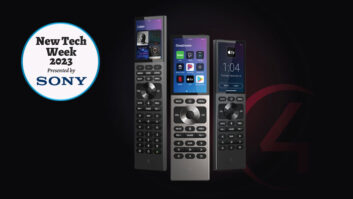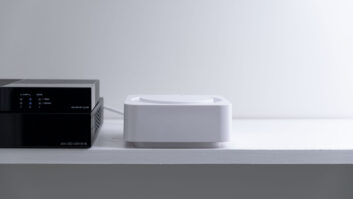Control4 recently started shipping its much-anticipated control system to dealers. cyberManor, the installation company run by Residential Systems columnist Gordon van Zuiden, set up a demonstration system of this new technology for its internal evaluation and also to show prospective customers. This article represents cyberManors initial findings on the installation, programming, and operation of the system.
System Configuration: Our demonstration system is based on the standard Dealer Evaluation System that was shipped to a select set of initial Control4 dealers.
It consisted of:
Media Controller and Remote
10.5-inch Wireless Touch Screen (802.11)
Power-over-Ethernet Mini Touch Panel
Three and Six Button Wireless (Zigbee) Keypads
Four Wireless (Zigbee) Dimmers and One Wireless (Zigbee) Switch
Control4 Composer software
All interconnecting cables, IR Emitters, etc
Motion Detector
Wireless Access point/Router (Supplied by us)
Receiver
DVD Player
TV Monitor
Speakers
Lights
Installation: We set up two A/V zones. One is a remote zone with the Mini Touch Panel and two amplified speakers, and the rest of the equipment went in the Theater zone. We wired two of the wireless dimmers and one wireless switch to test lights. The wireless six-button keypad we used also required 120VAC, so we wired that in with the dimmers and switch. The dimmers and keypad all communicate via Zigbee wireless to the Media Controller. The color choices for dimmers, switches, keypads and mini touch panels are the basic white, black or almond colors.
Keypads are available in three- and six-button models. A very useful feature is that each keypad has an LED that can be programmed along with any action to be virtually any color and intensity. This is also true of Dimmers and Switches, except that they have two LEDstop and bottom.
We then setup the wireless access point/router as a separate network from the showroom. The Media Controller and the Mini Touch Panel were connected by ethernet cables, and the Wireless Touch Screen via WiFi. All were configured by the DHCP server on the router, and we did not have to enter any static IP information. We normally prefer to configure equipment like the Media Controller with a static IP, but followed their tutorial for this installation.
Next, we loaded the Control4 Composer software on our Windows XP laptop (Composer only runs on Windows XP). We connected to the Media Controller, which the software auto-discovered. Alternately, we could have entered the IP address from the Media Controller and connected manually.
Device Drivers: Before we actually started programming, we downloaded device drivers from the online Control4 driver database. This is a very extensive database of drivers and all of our devices were easily found. We would prefer to use RS232 drivers with any equipment that will support it, but currently the online database only has IR device drivers. We could have built our own IR or RS232 drivers with the Composer Driver Wizard software, but decided to use the supplied drivers for this evaluation.
After downloading the device drivers, we first tested them before doing any programming. We connected IR emitters to the Media Controller and under Connections in the Composer software we told the Media Controller which IR output connects to which device. Then, by double-clicking on the device, a device control screen pops up. Clicking on the icons (power, volume, play, stop, etc.) allows you to send IR codes directly to the device. If a device does not react to the IR code correctly, you can use the Driver Wizard to edit the codes. We had this problem with the DVD player as it would not power on or off correctly, but once turned on, the transport controls worked correctly. We used the Driver Wizard to edit and correct the power problem, capturing the correct codes from the DVDs remote control into the Media Controllers IR receiver. One very important thing that you have to remember to do after editing a driver is to delete the existing driver from the system and re-add the edited driver (otherwise your changes will not take effect).
Programming: Programming is completed in one of two waysusing the Interviewer or using Composer wizards. The Interviewer takes you through adding rooms, then equipment in each room, then addressing the Zigbee devices. It takes you through these connections one at a time, and it is very helpful if you have a connection diagram or I/O list already completed. If you do not know the connections, they can be added later in either the Interviewer or Composer. It is a good starting point for first-time users, and one can get a system with basic functionality (like our demo system), configured and running in 15-20 minutes.
Like most integrators who will be integrating more than one or two rooms, we find it easier to start in the Composer wizard. In this software, under Systems Design, you drag-n-drop rooms, then drag-n-drop device drivers into each room. Moving to Connections, you can address all of your Zigbee and IP devices. This is also where you define all of your A/V I/O connections, again a drag-n-drop process. At this point you have a basic control of your system, i.e., lighting control, transport control, etc. The next step is to add some media content to play in the different zones.
The media view is a very easy-to-use tool to retrieve either stored or broadcast media content added to the system.
Stored content includes CDs, DVDs, disc changers and MP3 files. With all of the stored content, you search for the cover art to enable the Navigators (Touch Panel interfaces) to choose what to listen to or watch by cover arta much better end-user experience than scrolling through lists.
For broadcast media, you enter the zip code of the project and are presented with a list for the local area for DirecTV, Dish Network, Cable TV, UHF/VHF, and AM/FM/XM. You click on the content providers that you want to show on the navigators. Because this is an easy-to-use tool, Control4 is making available a Composer Media Edition for your customers to add or update their own media content.
With the touch panels connected, they need to be refreshed to get the latest updates. This takes a few minutes, but when done you are ready to play any of the media content you have added. If your customer has the Composer Media Edition, they will need to remember this too, or you will be getting a trouble call of media content not showing up on the touch panels.
At this point, all of your media content would be available on the Navigators and you could play or watch any of the content. To add more functionality and to be able to, for example, lower the lights when a DVD starts, you will need to make use of the Agents and Programming views.
Agents are pre-configured functional modules and Programming causes a module to execute. Agents can be Variables, Lighting Scenes, Schedules, Custom Navigator Buttons, and Wakeup. Wakeup provides an all-in-one scene of lights, music, and temperature settings. For example, you could program a lighting scene of lights that you want to come on at sunset, then program a scheduler to trigger daily at sunset. Finally, in Programming, click on the Sunset Scheduler Agent and choose to execute the Sunset Lighting scene. Control4 will soon be adding additional agents to simplify common feature and programming tasks.
The Custom Button Agent can be used to provide up to four screens of six buttons each on any of the Navigators (Touch Panels). This can be useful for opening and closing gates, initiating Lighting Scene Agents, etc. After programming the six-button keypad with lighting scenes and a Wakeup Agent, we were ready to exercise the system.
Operation: The initial operation of the system went smoothly. One plus in programming the Media Controller is that there is no compile-and-upload wait. If you make a change in the systems operation, then you can immediately see its effects. That makes it a lot easier to try what-if scenarios. Just remember to backup working revisions on a regular basis.
When playing audio streams in a multi-user environment we noticed no discernible lag between the sounds in the zones. We have only tested two zones so far, but we expect it will scale to more zones with no sound lag.
The Zigbee wireless dimmers, switches, and keypads all worked as programmed. We did have a problem with one dimmer dropping out of the Zigbee mesh network, but pulling out the Air Gap Mechanism reset the dimmer, and then it operated correctly. (The Air Gap Mechanism, when opened, completely disconnects power to the load. This ensures that there is no leakage current to the fixture during routine lamp maintenance. In addition, when the Air Gap Mechanism is open, no remote locations can re-energize the circuit.) We have not fully explored the limits of Zigbee within a house and some care needs to be taken in your layout so that there is a path between the devices and not an overly large gap that might hinder communications.
The Mini Touch Panel came with the LCD slightly askew. This may have happened in shipping, but it would not be acceptable in an actual installation. We have also had some issues with software and firmware compatibility. This had to do mainly with pre-release Composer software vs. the actual release of Version 1.0. (Control4 has said that all future versions would be backwards compatible.) Also, the Media Controller needed to have its firmware physically updated. This procedure will be easier when the final products are released and all Control4 product firmware can be upgraded in the field (and in many instances remotely upgraded).
Conclusion: Overall, we have been very pleased with the Version 1.0 product. We, and many other dealers we have talked to, plan to take it slow, doing some smaller projects until we know how well it will scale, how reliable it is, and how easy future upgrades will be.
Gordon van Zuiden ([email protected]) is president of cyberManor an Internet Home Solutions company in Los Gatos, California. Co-writer Rick Kalm served the engineer on his Control4 installation.







